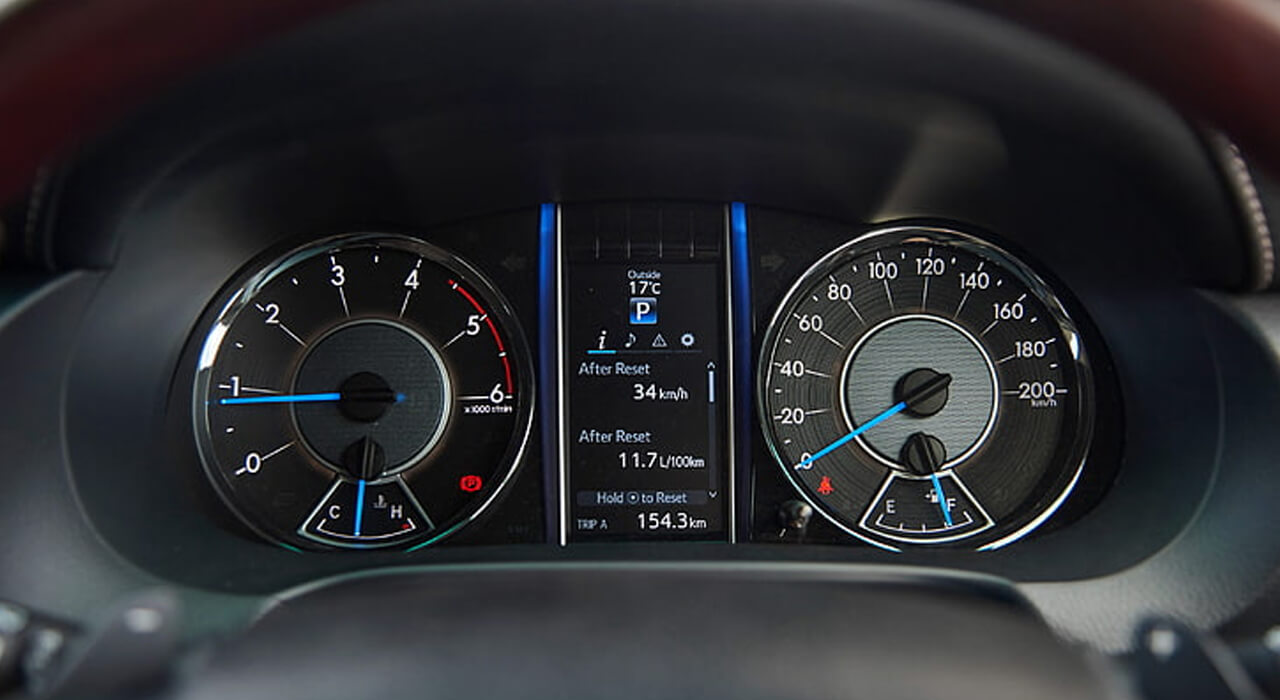Few aspects of car design are as important and visually appealing as gauge and instrument clusters. These displays serve as the interface between the vehicle and the driver, providing critical data like speed, fuel level, engine performance, etc. However, modern instrument clusters are more than just functional; they’re works of art that combine cutting-edge technology with a sleek design.
In this post, we’ll examine the fascinating world of gauge and instrument clusters, tracing their development over time and discussing how they contribute to a more satisfying driving experience.
What Is A Gauge Cluster?
A dashboard, an instrument cluster or gauge, assembles gauges and indicators typically mounted in a vehicle’s driver’s compartment. It’s where the driver will spend most of their time interacting with the car’s many systems. The gauge cluster shows the current speed, engine RPM, fuel level, and vehicle temperature.
The driver is better equipped to monitor the vehicle’s status, make well-informed decisions while behind the wheel, and react swiftly to any warnings or issues. The design, layout, and functioning of the instrument clusters vary by the make and model of the car. Indicators may be either digital screens or more conventional analog ones.
The Evolution of Gauge and Instrument Clusters
There was the gauge cluster even before the first automobiles had functioning speedometers or gas gauges. These aggregations, however, grew in complexity and sophistication as technology advanced. Digital displays have replaced analog dials in the majority of gauge clusters.
Suggestion: Best Convertible Top Cleaners Review 2023 To Maintain Your Ride.
With the introduction of digital displays, instrument clusters were given a new level of functionality and personalization. Standard features today include high-resolution displays, LED panels with several colors, and touch-sensitive buttons. Drivers may get a comprehensive view of their vehicle’s health because of the seamless integration of data from multiple sources, including navigation, entertainment, and diagnostics.
The Functionality of Gauge and Instrument Clusters
A vehicle’s performance, safety, and operating state can all be monitored through a cluster of gauges and instruments. Their basic function has not changed despite adding new features and technologies: to present the driver with vital information. Let’s take a closer look at the essential roles of gauge and instrument clusters:
Speedometer
One of the most critical components of a gauge cluster is the speedometer. It continuously measures and displays the vehicle’s speed, allowing the driver to monitor their speed and adhere to speed limits. Speedometers are usually marked clearly and have a needle representing the current speed.
Tachometer
The device known as the tachometer shows the engine’s revolutions per minute (RPM). It supports the driver in determining the engine’s operational state and optimizing gear shifts for optimum performance and fuel economy. It is especially essential in manual transmission automobiles since it allows drivers to swap gears at the proper RPM range.
Also Read: Best Dashboard Cleaner For Cars.
Fuel Gauge
The fuel gauge indicates the amount of petrol in the vehicle’s tank. It assists drivers in monitoring their fuel levels and avoiding abruptly running out of petrol. Fuel gauges can display the gasoline level using analog dials, digital readouts, or graphical representations for accuracy and ease of access.
Temperature Gauge
The gauge for temperature is responsible for measuring the temperature of the coolant in the engine. If the engine overheats, the fuel gauge warns the driver, indicating a potential problem that the driver needs to address. Monitoring the temperature gauge allows drivers to take the necessary precautions to avoid engine damage and assure peak performance.
Warning Lights and Indicators
Instrument clusters include warning lights and indicators to alert drivers to potential problems or malfunctions. Check engine lights, tire pressure monitoring system (TPMS) warnings, battery charge indicators, seatbelt reminders, and other indications may be present. These warning lights intend to draw the driver’s attention to problems that require rapid action or attention.
Trip Computer and Vehicle Diagnostics
A trip computer is a device found in many modern instrument clusters that provides additional information about the vehicle’s performance, such as average fuel consumption, miles to empty, trip distance, and more. Vehicle diagnostic data, such as fault codes or maintenance reminders, can also be shown to help drivers identify and handle any problems.
Integration with Advanced Features
As technology has improved, instrument clusters have become more integrated with modern car functions. Groups, for example, may display data from navigation systems, music controls, and phone connectivity. This connection allows drivers to access and operate these capabilities while remaining focused on the road.
Suggestion: Top Reasons Why A Car Makes Noise When Turning Right But Not Left
The operation of gauge and instrument clusters is vital for providing drivers with critical information regarding the performance and safety of their vehicles. Drivers may make informed judgments, maintain efficient driving, and respond quickly to warning or diagnostic messages by monitoring speed, fuel levels, engine RPM, and other information. As technology advances, we may expect more features and greater functionality to be integrated into gauge and instrument clusters, boosting the overall driving experience.
Aesthetics and Design Considerations
While practicality is the most crucial consideration, gauge and instrument clusters can add to the overall aesthetics of a vehicle’s interior. Designers create groups to match the vehicle’s brand identity, thereby creating a cohesive and visually pleasing cockpit environment.
Font styles, color palettes, and graphical representations are all design concerns for instrument clusters. Analog dials frequently include graceful and precise needle movements, but digital displays support dynamic animations and graphical data representations. Optional ambient lighting and backlighting improve the visual effect of instrument clusters, producing a sense of refinement and modernity.
Technological Advancements and Future Trends
Gauge and instrument clusters are primed for additional innovation as automobile technology advances. Augmented reality (AR) displays and heads-up displays (HUDs) are gaining popularity by projecting information directly onto the windshield, decreasing the need for drivers to shift their sight from the road. Furthermore, advanced flexible display technology may result in curved or wrap-around instrument clusters, providing a more immersive and futuristic user experience.
Furthermore, incorporating networking elements enables instrument clusters to sync with smartphones and other devices, allowing for the smooth integration of personal preferences and information.
Conclusion
From their humble beginnings, gauge and instrument clusters have come a long way. They have evolved from simple analog dials to sophisticated digital displays, becoming a significant feature of automobile design. These clusters provide drivers with important information while improving their driving experience by combining functionality and visual appeal. We should expect even more inventive and visually appealing instrument clusters in the future as technology advances. Gauge and instrument clusters will continue to play an essential part in converging automotive technology and design, whether a classic analog display or a cutting-edge digital interface.






